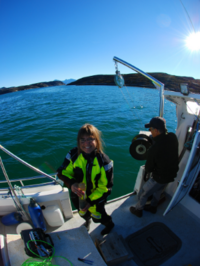Under havgræsenge ophobes organisk kulstof (OC) i sedimenterne, hvilket gør dem til anerkendte hot spots for kulstoflagring, idet deres kapacitet som kulstofdræn kan måles direkte ved at analysere sedimentkerner direkte fra havgræsengene. Tangskove er derimod ofte blevet ignoreret som kulstofdræn fordi de vokser på stenede kyster, hvor kulstof ikke ophobes. Dette har bremset brugen af konventionelle metoder til at vurdere tangskoves rolle i forhold til kulstoflagring på havbunden. Dog viser videnskabelige beregninger, at en betydelig del af den naturlige tangproduktion, 173 Tg kulstof per år, eksporteres og lagres uden for de områder, hvor de vokser. Men vi mangler i høj grad direkte og mere præcise estimater på, hvor meget tangskovene bidrager til havbundens kulstofdepoter, både I Arktis og andre steder i verden.
Både Arktiske tangskove og havgræsenge spreder sig pga. stigende havtemperaturer og reduceret havisdække, og således forventes de blå kulstofdræn i Arktis at blive større. Da Arktis repræsenterer 34 % af den globale kystlinje og primært består af stenede kyster, er potentialet for en større udbredelse af Arktiske marine skove og deres bidrag til blåt kulstof således signifikant.
We apply an interdisciplinary approach at the intersection of marine ecology, geology, oceanography, remote sensing, biochemistry and genetics, with Greenland as a case study. We do so by coupling new conceptual advances with the use of newly developed techniques for tracing carbon (C) from marine forests in Arctic marine sediments and fjord systems (e.g. environmental DNA, (amino acid) isotopic signatures & remote sensing). We combine measurements of bulk C, isotopic signatures of bulk C/amino acids and environmental DNA to resolve the sources of C to Arctic sediments and understand the role of Arctic marine forests in a global blue carbon context.

Environmental DNA (eDNA) represents DNA extracted from environmental samples (e.g. soil, water and air). The method enables us to get a wide palette of taxonomic information about the environmental sample, as it specifically identifies the organisms that have been in contact with the studied environment. In this project, we develop and apply methods for studying the traces of DNA from marine forests in Arctic sediments, both using metabarcoding and quantitative PCR. Further, we study the relation between carbon biomass and eDNA derived from macroalgae in particular.
The method is demonstrated in one of our latest publications at: http://doi.org/10.1002/edn3.262
Isotopic analysis is the most used method for tracing sources of organic matter and is especially applied in food web analyses to determine trophic levels. Statistical tools (e.g. Bayesian mixing modelling) are applied to stable isotope ratios, such as δ13C and δ15N, obtained from both the studied samples and the expected sources/end members. However, the results are often difficult to interpret, especially when the number of potential sources is high or alike in isotopic composition, such as, for example, macroalgae and microalgae. New developments using stable isotopic ratios of amino acids may improve the resolution between sources like macroalgae and microalgae, and in this project, we explore both traditional and new methods of isotopic analyses to estimate the C contributions from marine forests in Arctic sediments.
Remote sensing is typically applied to derive estimates or changes in areal abundance and biomass of organisms in space and time. In this project, we apply computational image analyses of drone-images and satellite-images to derive the areal cover of floating macroalgae in coastal areas of the Arctic. In addition, we use GPS-trackers to track floating macroalgae and their transport routes in Arctic fjord systems.
The method is demonstrated in our two latest publications at: https://doi.org/10.1016/j.scitotenv.2022.161213 and https://doi.org/10.1016/j.scitotenv.2023.162224
Tasks:
Tasks:
Tasks: